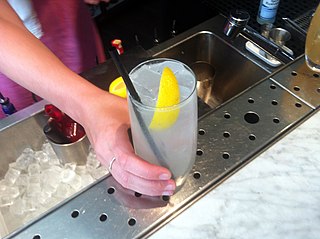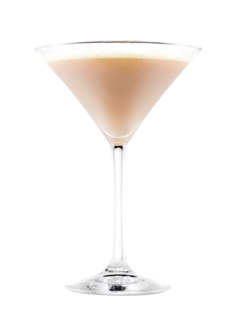
The Tom Collins is a Collins cocktail made from gin, lemon juice, sugar, and carbonated water. First memorialized in writing in 1876 by Jerry Thomas, "the father of American mixology", this "gin and sparkling lemonade" drink is typically served in a Collins glass over ice. A "Collins mix" can be bought premixed at stores and enjoyed alone or with gin.

French 75 is a cocktail made from gin, champagne, lemon juice, and sugar. It is also called a 75 Cocktail, or in French simply a Soixante Quinze.

The martini is a cocktail made with gin and vermouth, and garnished with an olive or a lemon twist. Over the years, the martini has become one of the best-known mixed alcoholic beverages. A popular variation, the vodka martini, uses vodka instead of gin for the cocktail's base spirit.

A Stinger is a duo cocktail made by adding crème de menthe to brandy. The cocktail's origins can be traced to the United States in the 1890s, and the beverage remained widely popular in America until the 1970s. It was seen as a drink of the upper class, and has had a somewhat wide cultural impact.

A sour is a traditional family of mixed drinks. Sours belong to one of the old families of original cocktails and are described by Jerry Thomas in his 1862 book How to Mix Drinks.

The Bronx is a cocktail. It is essentially a Perfect Martini with orange juice added. It was ranked number three in "The World's 10 Most Famous Cocktails in 1934" behind the Martini (#1) and the Manhattan (#2). In the 1934 movie "The Thin Man", the lead actor compared the methods for shaking the Manhattan, the Bronx and the Martini.

The Fine Art of Mixing Drinks is a book about cocktails by David A. Embury, first published in 1948. The book is noteworthy for its witty, highly opinionated and conversational tone, as well as its categorization of cocktails into two main types: aromatic and sour; its categorization of ingredients into three categories: the base, modifying agents, and special flavorings and coloring agents; and its 1:2:8 ratio for sour type cocktails.

A "fizz" is a mixed drink variation on the older sours family of cocktail. Its defining features are an acidic juice and carbonated water.

The Pegu Club or the Pegu is a gin-based cocktail that was the signature drink of Burma's Pegu Club. The club was located just outside Rangoon, and its members were those Britons who were senior government and military officials and prominent businessmen. The club was named after the Pegu, a Burmese river.

The Alexander is a cocktail consisting of gin, cocoa liqueur, and cream. A variation, the Brandy Alexander, uses cognac instead of gin.

The Pink Lady is a classic gin-based cocktail with a long history. Its pink color is due to adding grenadine.

A lemon drop is a vodka-based cocktail that has a lemony, sweet and sour flavor, prepared using lemon juice, triple sec and simple syrup. It has been described as a variant of, or as "a take on", the Vodka Martini, but is in actual fact a closer to a White Lady variant. It is typically prepared and served straight up – chilled with ice and strained.

The Casino is an IBA official cocktail made with gin, maraschino liqueur, orange bitters and fresh lemon juice.
The Zazarack cocktail, later spelled Zazarac, is an American cocktail which may be related to the Sazerac, although it might have originated completely independent of the more famous drink.

A Damn the Weather is a Prohibition Era cocktail made with Gin, sweet vermouth, orange juice, and a sweetener. It is served shaken and chilled, often with a slice of orange or other citrus fruit.
The Blackthorn is an Irish whiskey or sloe gin based cocktail. Both versions emerged in the late 19th and early 20th century.
Arsenic and Old Lace is a classic cocktail with its origins in the 1910's made with gin, crème de violette, dry vermouth and absinthe.

The Airmail or Air Mail is a classic cocktail based on rum, lime or lemon juice, honey, and sparkling wine. It was probably created during or shortly after the period of prohibition in the United States of America or on Cuba, i.e. in the 1920s or 1930s.

















